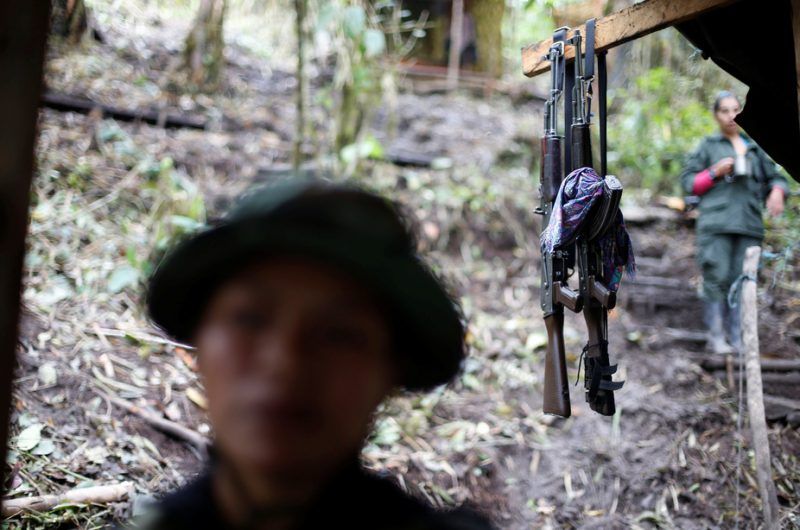
In Colombia, the November 2016 agreement between the FARC guerillas and the Colombian government has brought the promise of peace for the country and compelled a significant reduction in FARC-related violence.
But the road ahead remains daunting. The FARC agreement has not implied a reduction in the military actions of other groups, such as the EPL, the ELN or right-wing warlords (known in Colombia as paramilitaries). At least 80 human rights activists were assassinated in 2016, and some sources report more than 125.
Tensions are particularly flaring around delays in implementing the accords – that is, actually putting into action the decisions written down on paper. Challenges setting up FARC “centralisation zones”, which will host guerrillas as they surrender their weapons and transition into civilian life, exemplify the predicament facing president Juan Manuel Santos’ government: implementing the agreements to change the course of Colombia’s history requires confronting the both the root causes and the nefarious outcomes of its 50-year armed conflict.
Time to get to work
The “zonas de concentración” (literally, concentration zones) are a central point in the sub-agreement on disarmament and reintegration. According to the peace accords, more than 20 camps would be established across Colombia, with oversight from the United Nations and security provided by the Colombian armed forces.
These camps represent the government’s commitment to defend the life and integrity of former rebels. They also, critically, demonstrate the Colombian state’s reassertion of the monopoly of violence in the country.
The government was supposed to have put in place the security protocols to operationalise this process within 180 days of treaty ratification, but UN specialists recently announced that the centralisation zones won’t be ready until the end of March and questioned the feasibility of the deadline.
The FARC has seized on these delays to question Santos’ commitment to implementing the agreements. But such claims ignore the fact that the government is indeed trying to follow through – it’s just struggling to do so in zones where other armed actors, including drug traffickers, still operate.
The government has put pressure on local institutions and is trying to mobilise actors, resources and plans, but it’s not clear that state institutions have the capacity to fulfil their mandate.
To make matter worse, some politicians, including the influential former president Álvaro Uribe, have campaigned against the FARC agreements. “Repeal and renegotiate” has become a rallying cry for conservative candidates in the 2018 presidential election (though they’re oddly silent about the assassinations of activists), and the possibility of change in the executive is making risk-averse bureaucrats slower to act than usual.
Such uncertainty risks mobilising dissidents within the FARC and justifying their assertions that the government’s commitment to peace is flagging.
Local weaknesses
In truth, the challenges in implementing the accords are more indicative of the major difference in capacity between the national government and local state institutions.
The centralisation camps are setting up shop, logically, in areas where the FARC had formerly exerted its influence. But because they used to be controlled by the FARC, local government in these areas is fragile.
The Santos administration is confronting the reality of trying to work with sectors of its own state that are ineffective, corrupt, slow and still easily captured by armed non-state or fringe actors. The issue of feeble local governments was foreseeable, and it informed the peace negotiations, but the capacity gap between the national government and provincial institutions is clearly greater than anticipated.
Understanding the difference between the concepts of the government and the state is key. The former refers to the current executive leadership (the Santos administration), the latter to Colombia’s national institutions and to the political apparatus in a particular territory.
Colombia finds itself in the uncomfortable position of having a government that wants to implement the peace agreements it signed but a state that’s either too weak or too peripheral to execute orders.
Blaming the government for the slow pace of the peace process, as the FARC leadership has done, ignores these profound structural problems – problems they helped create. Not only are weak state institutions primarily responsible for the delays, but they’re also the reason guerrilla groups like the FARC came about in the first place – and then weakened them further.
The high legislative and executive capacity present in the capital of Bogota, home to a national government capable of embarking on an ambitious project like peace, is in stark contrast with provincial institutions. In remote areas, many governments have proven unable to provide essential services to the people (education, water, roads), and have been vulnerable to being replaced, controlled or influenced by armed actors.
Armed groups have been surpassing the capacity of the state in far-flung regions for over a century (the secession of Panama from Colombia between 1899 and 1902 being a prime early example).
Consecutive administrations since the mid-20th century have tried, and failed, to fully reunify state institutions and reestablish the monopoly of violence across all Colombia’s territory. Implementing the FARC peace agreement, and any future agreement with other guerilla groups now in negotiations, once again offers this opportunity – and embody this challenge.
Herein lies Colombia’s great contradiction: internal conflict engendered a feeble state, and today, as the country seeks to enable its most powerful guerilla group to lay down arms, that institutional weakness is a monumental hurdle. If the nation succeeds in setting up the FARC centralisation camps, Colombia may find peace in spite of itself.
Fabio Andres Diaz, Researcher on Conflict, Peace and Development, International Institute of Social Studies
